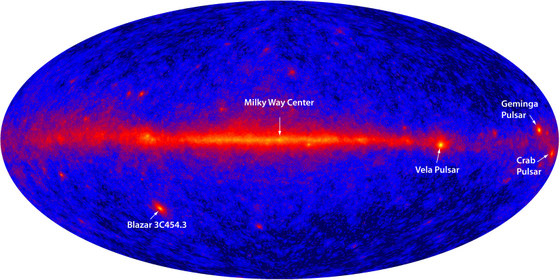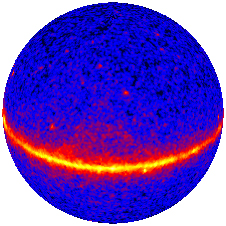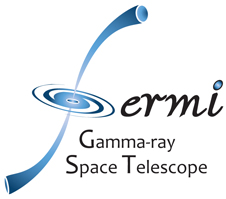C'est avec grand plaisir que j'ouvre ce thread..
Glast (heu.. Fermi) fonctionne a merveille !
Surprises a l'horizon !!
-------------------------------
Premières images de Glast
Lancé en juin 2008, le satellite GLAST rebaptisé « Fermi Gamma-Ray Space Telescope » en l'honneur du professeur Enrico Fermi (1901-1945), a livré ses premières images après une série de tests visant à calibrer ses deux instruments, le LAT (Large Area Telescope) et le GBM (GLAST Burst Monitor).
Dédié à l’observation des rayons gamma, un rayonnement électromagnétique composé de photons de haute énergie, FERMI peut détecter les évènements les plus violents de l’Univers : sursauts gamma, supernovae, émissions des noyaux galactiques actifs…
La première image générée montre le gaz brillant de la Voie Lactée, des pulsars clignotants et une galaxie située à des milliards d'années lumière particulièrement lumineuse en raison d'un épisode d'activité intense. Il a fallu 95 heures d’observation pour la réaliser mais une image similaire produite par le précédent satellite de la NASA, CGRO (Compton Gamma-Ray Observatory), avait demandé des années d'observation.
Durant l’année à venir, le satellite balaiera le ciel avec le LAT toutes les trois heures ce qui permettra aux scientifiques de surveiller l'activité de sources rapidement variables. Au cours de cette période, les astronomes s’attendent à ce qu’il débusque des milliers de nouvelles sources Gamma. Après cette première phase, ils fixeront plus longtemps certaines zones de l’espace notamment aux abords des trous noirs supermassifs logés au cœur des galaxies où ont lieu des phénomènes encore mal compris.
J.I.
Sciences et Avenir.com
28/08/2008
Glast (heu.. Fermi) fonctionne a merveille !
Surprises a l'horizon !!
-------------------------------
Premières images de Glast
Lancé en juin 2008, le satellite GLAST rebaptisé « Fermi Gamma-Ray Space Telescope » en l'honneur du professeur Enrico Fermi (1901-1945), a livré ses premières images après une série de tests visant à calibrer ses deux instruments, le LAT (Large Area Telescope) et le GBM (GLAST Burst Monitor).
Dédié à l’observation des rayons gamma, un rayonnement électromagnétique composé de photons de haute énergie, FERMI peut détecter les évènements les plus violents de l’Univers : sursauts gamma, supernovae, émissions des noyaux galactiques actifs…
La première image générée montre le gaz brillant de la Voie Lactée, des pulsars clignotants et une galaxie située à des milliards d'années lumière particulièrement lumineuse en raison d'un épisode d'activité intense. Il a fallu 95 heures d’observation pour la réaliser mais une image similaire produite par le précédent satellite de la NASA, CGRO (Compton Gamma-Ray Observatory), avait demandé des années d'observation.
Durant l’année à venir, le satellite balaiera le ciel avec le LAT toutes les trois heures ce qui permettra aux scientifiques de surveiller l'activité de sources rapidement variables. Au cours de cette période, les astronomes s’attendent à ce qu’il débusque des milliers de nouvelles sources Gamma. Après cette première phase, ils fixeront plus longtemps certaines zones de l’espace notamment aux abords des trous noirs supermassifs logés au cœur des galaxies où ont lieu des phénomènes encore mal compris.
J.I.
Sciences et Avenir.com
28/08/2008






Commentaire